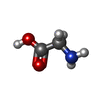[English] 日本語
 Yorodumi
Yorodumi- PDB-5dex: Crystal structure of GluN1/GluN2A NMDA receptor agonist binding d... -
+ Open data
Open data
- Basic information
Basic information
| Entry | Database: PDB / ID: 5dex | ||||||
|---|---|---|---|---|---|---|---|
| Title | Crystal structure of GluN1/GluN2A NMDA receptor agonist binding domains with glycine and antagonist, phenyl-ACEPC | ||||||
 Components Components |
| ||||||
 Keywords Keywords | TRANSPORT PROTEIN / RECEPTOR | ||||||
| Function / homology |  Function and homology information Function and homology informationneurotransmitter receptor transport, plasma membrane to endosome / regulation of response to alcohol / response to ammonium ion / receptor recycling / directional locomotion / response to environmental enrichment / pons maturation / positive regulation of Schwann cell migration / regulation of cell communication / EPHB-mediated forward signaling ...neurotransmitter receptor transport, plasma membrane to endosome / regulation of response to alcohol / response to ammonium ion / receptor recycling / directional locomotion / response to environmental enrichment / pons maturation / positive regulation of Schwann cell migration / regulation of cell communication / EPHB-mediated forward signaling / Assembly and cell surface presentation of NMDA receptors / response to hydrogen sulfide / auditory behavior / olfactory learning / conditioned taste aversion / dendritic branch / serotonin metabolic process / regulation of respiratory gaseous exchange / response to other organism / protein localization to postsynaptic membrane / regulation of ARF protein signal transduction / cellular response to magnesium ion / transmitter-gated monoatomic ion channel activity / positive regulation of inhibitory postsynaptic potential / suckling behavior / response to methylmercury / response to manganese ion / response to glycine / propylene metabolic process / sleep / response to carbohydrate / regulation of NMDA receptor activity / locomotion / dendritic spine organization / cellular response to dsRNA / cellular response to lipid / regulation of monoatomic cation transmembrane transport / RAF/MAP kinase cascade / NMDA glutamate receptor activity / Synaptic adhesion-like molecules / voltage-gated monoatomic cation channel activity / response to glycoside / NMDA selective glutamate receptor complex / glutamate binding / ligand-gated sodium channel activity / neurotransmitter receptor complex / response to morphine / regulation of axonogenesis / glutamate receptor signaling pathway / neuromuscular process / calcium ion transmembrane import into cytosol / regulation of dendrite morphogenesis / protein heterotetramerization / male mating behavior / regulation of synapse assembly / glycine binding / spinal cord development / response to amine / parallel fiber to Purkinje cell synapse / cellular response to zinc ion / startle response / dopamine metabolic process / positive regulation of reactive oxygen species biosynthetic process / monoatomic cation transmembrane transport / response to lithium ion / response to light stimulus / positive regulation of calcium ion transport into cytosol / regulation of postsynaptic membrane potential / cellular response to glycine / associative learning / modulation of excitatory postsynaptic potential / action potential / conditioned place preference / excitatory synapse / positive regulation of dendritic spine maintenance / monoatomic cation transport / social behavior / regulation of neuronal synaptic plasticity / positive regulation of protein targeting to membrane / glutamate receptor binding / monoatomic ion channel complex / Unblocking of NMDA receptors, glutamate binding and activation / positive regulation of excitatory postsynaptic potential / long-term memory / synaptic cleft / neuron development / prepulse inhibition / phosphatase binding / multicellular organismal response to stress / positive regulation of synaptic transmission, glutamatergic / postsynaptic density, intracellular component / monoatomic cation channel activity / calcium ion homeostasis / response to fungicide / glutamate-gated receptor activity / cell adhesion molecule binding / regulation of neuron apoptotic process / cellular response to manganese ion / presynaptic active zone membrane / neurogenesis Similarity search - Function | ||||||
| Biological species |  | ||||||
| Method |  X-RAY DIFFRACTION / X-RAY DIFFRACTION /  SYNCHROTRON / SYNCHROTRON /  MOLECULAR REPLACEMENT / Resolution: 2.4 Å MOLECULAR REPLACEMENT / Resolution: 2.4 Å | ||||||
 Authors Authors | Mou, T.-C. / Conti, P. / Pinto, A. / Tamborini, L. / Sprang, S.R. / Hansen, K.B. | ||||||
| Funding support |  United States, 1items United States, 1items
| ||||||
 Citation Citation |  Journal: Proc. Natl. Acad. Sci. U.S.A. / Year: 2017 Journal: Proc. Natl. Acad. Sci. U.S.A. / Year: 2017Title: Structural basis of subunit selectivity for competitive NMDA receptor antagonists with preference for GluN2A over GluN2B subunits. Authors: Lind, G.E. / Mou, T.C. / Tamborini, L. / Pomper, M.G. / De Micheli, C. / Conti, P. / Pinto, A. / Hansen, K.B. | ||||||
| History |
|
- Structure visualization
Structure visualization
| Structure viewer | Molecule:  Molmil Molmil Jmol/JSmol Jmol/JSmol |
|---|
- Downloads & links
Downloads & links
- Download
Download
| PDBx/mmCIF format |  5dex.cif.gz 5dex.cif.gz | 128 KB | Display |  PDBx/mmCIF format PDBx/mmCIF format |
|---|---|---|---|---|
| PDB format |  pdb5dex.ent.gz pdb5dex.ent.gz | 97.1 KB | Display |  PDB format PDB format |
| PDBx/mmJSON format |  5dex.json.gz 5dex.json.gz | Tree view |  PDBx/mmJSON format PDBx/mmJSON format | |
| Others |  Other downloads Other downloads |
-Validation report
| Summary document |  5dex_validation.pdf.gz 5dex_validation.pdf.gz | 820.3 KB | Display |  wwPDB validaton report wwPDB validaton report |
|---|---|---|---|---|
| Full document |  5dex_full_validation.pdf.gz 5dex_full_validation.pdf.gz | 828.6 KB | Display | |
| Data in XML |  5dex_validation.xml.gz 5dex_validation.xml.gz | 23.7 KB | Display | |
| Data in CIF |  5dex_validation.cif.gz 5dex_validation.cif.gz | 33.1 KB | Display | |
| Arichive directory |  https://data.pdbj.org/pub/pdb/validation_reports/de/5dex https://data.pdbj.org/pub/pdb/validation_reports/de/5dex ftp://data.pdbj.org/pub/pdb/validation_reports/de/5dex ftp://data.pdbj.org/pub/pdb/validation_reports/de/5dex | HTTPS FTP |
-Related structure data
| Related structure data |  5vihC  5viiC  5vijC  4nf8S C: citing same article ( S: Starting model for refinement |
|---|---|
| Similar structure data |
- Links
Links
- Assembly
Assembly
| Deposited unit | 
| ||||||||
|---|---|---|---|---|---|---|---|---|---|
| 1 |
| ||||||||
| Unit cell |
|
- Components
Components
| #1: Protein | Mass: 33340.031 Da / Num. of mol.: 1 / Fragment: UNP residues 394-544, 663-800 Source method: isolated from a genetically manipulated source Source: (gene. exp.)   |
|---|---|
| #2: Protein | Mass: 31785.299 Da / Num. of mol.: 1 / Fragment: UNP residues 402-539, 661-802 Source method: isolated from a genetically manipulated source Source: (gene. exp.)   |
| #3: Chemical | ChemComp-GLY / |
| #4: Chemical | ChemComp-5E0 / |
| #5: Water | ChemComp-HOH / |
| Has protein modification | Y |
| Sequence details | AUTHORS STATE THAT THIS SEQUENCE CORRESPONDS TO THE NCBI REFERENCE SEQUENCE NP_036705.3 FOR GLUN2A. ...AUTHORS STATE THAT THIS SEQUENCE CORRESPOND |
-Experimental details
-Experiment
| Experiment | Method:  X-RAY DIFFRACTION X-RAY DIFFRACTION |
|---|
- Sample preparation
Sample preparation
| Crystal | Density Matthews: 2.24 Å3/Da / Density % sol: 45.19 % |
|---|---|
| Crystal grow | Temperature: 293 K / Method: vapor diffusion, hanging drop / Details: AMMONIUM ACETATE, PEG 4000 |
-Data collection
| Diffraction | Mean temperature: 100 K |
|---|---|
| Diffraction source | Source:  SYNCHROTRON / Site: SYNCHROTRON / Site:  APS APS  / Beamline: 19-ID / Wavelength: 0.9794 Å / Beamline: 19-ID / Wavelength: 0.9794 Å |
| Detector | Type: ADSC QUANTUM 315r / Detector: CCD / Date: Jun 12, 2015 |
| Radiation | Monochromator: sI (111) / Protocol: SINGLE WAVELENGTH / Monochromatic (M) / Laue (L): M / Scattering type: x-ray |
| Radiation wavelength | Wavelength: 0.9794 Å / Relative weight: 1 |
| Reflection | Resolution: 2.4→20 Å / Num. obs: 25970 / % possible obs: 97.7 % / Redundancy: 4.4 % / Net I/σ(I): 6.69 |
| Reflection shell | Resolution: 2.4→2.49 Å / Redundancy: 3 % / Mean I/σ(I) obs: 1.37 / % possible all: 90.6 |
- Processing
Processing
| Software |
| ||||||||||||||||||||||||||||||||||||||||||||||||||||||||||||||||||||||||||||||||||||||||||||||||||
|---|---|---|---|---|---|---|---|---|---|---|---|---|---|---|---|---|---|---|---|---|---|---|---|---|---|---|---|---|---|---|---|---|---|---|---|---|---|---|---|---|---|---|---|---|---|---|---|---|---|---|---|---|---|---|---|---|---|---|---|---|---|---|---|---|---|---|---|---|---|---|---|---|---|---|---|---|---|---|---|---|---|---|---|---|---|---|---|---|---|---|---|---|---|---|---|---|---|---|---|
| Refinement | Method to determine structure:  MOLECULAR REPLACEMENT MOLECULAR REPLACEMENTStarting model: PDB ENTRY 4NF8 Resolution: 2.4→14.969 Å / SU ML: 0.38 / Cross valid method: FREE R-VALUE / σ(F): 1.35 / Phase error: 28.01 / Stereochemistry target values: ML
| ||||||||||||||||||||||||||||||||||||||||||||||||||||||||||||||||||||||||||||||||||||||||||||||||||
| Solvent computation | Shrinkage radii: 0.9 Å / VDW probe radii: 1.11 Å / Solvent model: FLAT BULK SOLVENT MODEL | ||||||||||||||||||||||||||||||||||||||||||||||||||||||||||||||||||||||||||||||||||||||||||||||||||
| Refinement step | Cycle: LAST / Resolution: 2.4→14.969 Å
| ||||||||||||||||||||||||||||||||||||||||||||||||||||||||||||||||||||||||||||||||||||||||||||||||||
| Refine LS restraints |
| ||||||||||||||||||||||||||||||||||||||||||||||||||||||||||||||||||||||||||||||||||||||||||||||||||
| LS refinement shell |
|
 Movie
Movie Controller
Controller



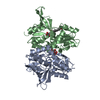

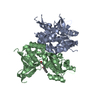

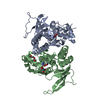

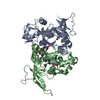
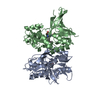

 PDBj
PDBj




